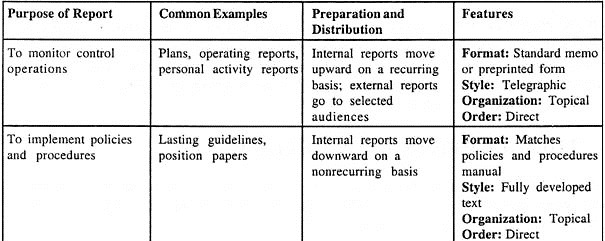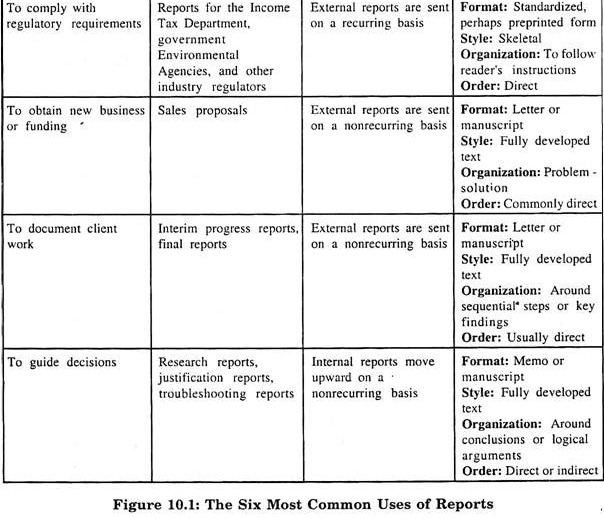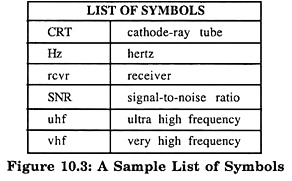This article throw slight upon the eight main elements of a report. The elements are: 1. Letter of Transmittal 2. Title Page 3. Abstract 4. Table of Contents 5. List of Illustrations 6. Executive Summary 7. Glossary and List of Symbols 8. Appendix.
Element # 1. Letter of Transmittal:
The letter of transmittal introduces the purpose and content of the report to the principal reader, usually (but not always) the person who requested the report. The letter is attached to the report or simply placed on top of it. Some organizations prefer a memo format if the report is intra-organizational.
The letter of transmittal (or memo) gives you an opportunity to emphasize whatever you feel your reader will find particularly important or interesting in the attached materials. It also enables you to point out any errors or omissions in the material. For example, you might want to include some information that was gathered after the report was typed or printed.
Transmittal letters generally contain most of the following elements:
ADVERTISEMENTS:
a. A statement of the title, and, if necessary, the purpose of the report;
b. A statement of who authorized or commissioned the project, and when;
c. A statement of the methods used in the project (if they are noteworthy) or of the principal results, conclusions and recommendations;
ADVERTISEMENTS:
d. An acknowledgment of any assistance you received in preparing the material;
e. A gracious offer to assist in interpreting the material or in carrying out further projects.
The transmittal letter/memo is informal and conversational (uses personal pronouns) in style.
Element # 2. Title Page:
The only difficulty in creating the title page is to think of a good title. The other blocks of information – the date of submission, the names and positions of the writer (or organization) and the principal reader (or organization) are simply identifying information.
ADVERTISEMENTS:
A good title is sufficiently informative without being unwieldy. It answers two basic questions: what is the subject of the report?; and what type of report is it?
For the Armada Corporation: A Self Insurance Fund to Effectively Deal With Our Outside Director Liability-Insurance Situation.
For the Wash and Shop Corporation: A Facility and Service Improvement Program to Effectively Deal With the Chain Laundromat Competition Situation.
An Efficient Layout of Maintenance Facilities in the North Block of the Raipur State Forest.
ADVERTISEMENTS:
These descriptive titles identify the subject, and by stating the recommendation they indicate that it is a “recommendation” report. A convenient way to define the type of report is to use a generic term such as analysis, recommendation, summary, review, guide, or instructions.
For example:
Open Sea Pollution-Control Devices: A Summary
An Analysis of the Tata 1013 Packager
ADVERTISEMENTS:
Where possible, however, use a descriptive title.
In some organizations, a title page is preceded by a title fly. The title fly is a plain sheet of paper with only the title on it. It is not really necessary, but it adds a touch of formality to the report.
Element # 3. Abstract:
An abstract is a brief technical summary – usually no more than 200 words – of the report. The abstract of a report is directed primarily to readers who are familiar with the technical subject and need to know whether to read the full report.
So, when writing an abstract you can use technical terminology freely and refer to advanced concepts in your field.
ADVERTISEMENTS:
Because abstracts can be useful before and after a report is read – and can even be read in place of the report – they are duplicated and kept on file in many divisions of the organization. And, of course, a copy of the abstract is attached to or placed within the report.
The two basic types of abstracts are generally called descriptive and informative abstracts. The descriptive abstract is rapidly losing popularity, whereas the informative abstract is becoming the accepted standard.
The descriptive abstract, sometimes called the topical or table of contents abstract, does only what its name implies. It simply describes the topics covered in the table of contents, giving equal coverage to each. So in this type of abstract the research methods, for example, would be mentioned even if they were not the focus of the report.
The informative abstract presents the major information that the report conveys. Instead of merely conveying all the topics in a superficial manner, it states the problem, the scope and methods (if appropriate), and the major results, conclusions, or recommendations.
ADVERTISEMENTS:
The basic structure of the informative abstract includes three elements:
a. The identifying information:
The name of the report, the writer, and perhaps the writer’s department.
b. The problem statement:
One or two sentences that define the problem or need that led to the project. Without an adequate problem statement to guide them, many readers will be unable to understand the abstract.
c. The important findings:
ADVERTISEMENTS:
The final three or four sentences – the biggest portion of the abstract – state the crucial information the report contains. Generally, this means some combination of results, conclusions, recommendations, and implications for other projects.
Sometimes, however, the abstract presents other information. For instance, many technical projects focus on new or unusual methods for achieving results that have already been obtained through other means. In such a case, the abstract will focus on the methods, not the results.
Element # 4. Table of Contents:
This element is crucial to the report because it enables different readers to turn to specific pages to find the information they want. No matter how well organized the report itself may be, a table of contents that does not make the structure clear will be ineffective.
Because a report usually has no index, the table of contents will provide the only guide to the report’s structure, coverage and pagination. The headings listed in the table of contents are identical to the headings that appear in the report itself.
To create an effective table of contents, therefore, you must first make sure the report has effective headings – and that it has enough of them. If the table of contents shows no entry for five or six pages, the report could probably be divided into additional subunits. In fact, some tables of contents have a listing of every page in the report.
If you use a clear system of headings within the report, you should be able to use the same system on your contents page. In other words, you can create an informative table of contents by listing your headings in the same style in which they appear in the text, using capitalization, underlining, indentation and italics.
ADVERTISEMENTS:
After creating the table of contents, review the report to make sure that the headings in the table of contents are written just as they appear in the report. The wording and the format must be the same. Such correspondence between the table of contents and the body of the report helps the readers understand and remember the structure of the report.
Element # 5. List of Illustrations:
A list of illustrations is a table of contents for the figures and tables of a report. If the report contains figures, but not tables, the list is called a list of figures. If the report contains tables but not figures, the list is called a list of tables. If the report contains both figures and tables, figures are listed separately, before the list of tables, and the two lists together are called a list of illustrations.
Element # 6. Executive Summary:
The executive summary (sometimes called the epitome, the executive overview, the management summary, or the management overview) is a one page condensation of the report. Its audience is made up of managers who rely on executive summaries to cope with the tremendous amount of paper crossing their desk every day.
Managers do not need or want a deep or detailed understanding of the various projects undertaken in their organizations; what managers do need is a broad understanding of the projects and how they fit into a coherent whole. Consequently a one-page (double spaced) maximum for the executive summary has become almost an unwritten standard.
The special needs of managers dictate a two-part structure for the executive summary:
a. Background:
ADVERTISEMENTS:
Because managers are not technically competent in the writer’s field, the background of the project is discussed clearly and completely. The specific problem is stated explicitly.
b. Major findings and implications:
Managers are not interested in the details of the project, so the methods – often the largest portion of the report – rarely receive more than one or two sentences. The conclusions and recommendations, however, are discussed in a full paragraph.
For instance, if the research and development division at an automobile manufacturer has created a composite material that can replace steel in car axles, the technical details of the report might deal with the following kinds of questions:
i. How was the composite devised?
ii. What are its chemical and mechanical structures?
ADVERTISEMENTS:
iii. What are its properties?
The managerial implications, on the other hand, involve other kinds of questions:
i. Why is this composite better than steel?
ii. How much do the raw materials cost? Are they readily available?
iii. How difficult is it to make the composite? Are there physical limitations to the amount we can make?
… And so on.
ADVERTISEMENTS:
The executives don’t care about chemistry; they want to know how this project can help them make a better product for less money. And since they are non-specialists, writers must avoid or downplay specialized vocabulary and explain the subject without referring to advanced concepts.
The placement of the executive summary highlights its importance. The current practice in business and industry is to place the executive summary before the detailed discussion. To highlight the importance of the executive summary further, it is listed in the table of contents in the same format as the major headings.
Element # 7. Glossary and List of Symbols:
A glossary is an alphabetical list of definitions. Such a list is particularly useful if you are addressing a multiple audience that includes readers who will not be familiar with the technical vocabulary used in your report.
Instead of slowing down the detailed discussion by defining technical terms as they appear, you can use an asterisk or some other form of notation to inform your readers that the term is defined in the glossary. A footnote at the bottom of the page on which the first asterisk appears serves to clarify the system for the readers.
Although the glossary is generally placed near the end of the report, right before the appendixes, it can also be placed right after the table of contents. This placement is appropriate if the glossary is brief (less than a page) and defines terms that are essential for managers likely to read the body of the report. Figure 10.2 provides an example of a glossary.
A list of symbols is structured like a glossary, but instead of defining words and phrases, it defines the symbols used in the report (so that readers don’t misinterpret them). Figure 10.3 provides an example of a list of symbols (in this case, abbreviations). Like the glossary, the list of symbols may be placed before the appendixes or after the table of contents.
Element # 8. Appendix:
An appendix is any section that follows the body of the report and the back matter (i.e. bibliography, glossary, list of symbols). Appendixes provide a convenient way to convey information that is too bulky to be presented in the body or that will be of interest to only a small number of the report’s readers.
For the sake of conciseness, this information is separated from the body of the report. Maps, large technical diagrams or charts, computations, computer printouts, test data, and texts of supporting documents are usually found in appendixes.
Appendixes, which are usually lettered rather than numbered (Appendix A, Appendix B, etc.), are listed in the table of contents and are referred to at the appropriate points in the body of the report. An item in an appendix is titled “Appendix”.
The item is not called “Figure” or “Table” even if it would have been so designated had it appeared in the body of the report. Before moving on to the next section, read the checklist in figure 10.4. This checklist will help you make sure you have included the appropriate elements in your report and written them correctly.



